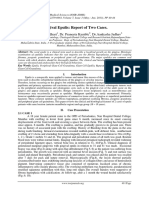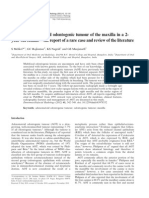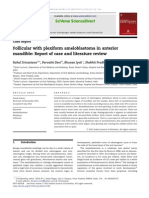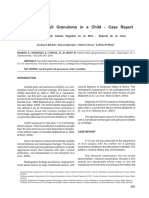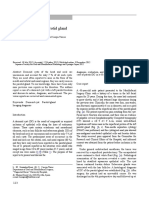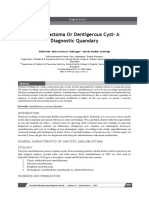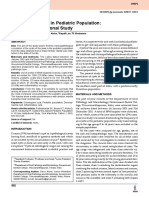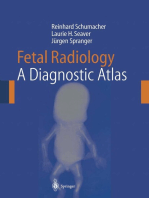0 ratings0% found this document useful (0 votes)
65 viewsGorlins Syndrome
Gorlins Syndrome
Uploaded by
Anupama NagrajThis case report describes a 13-year old female patient diagnosed with Gorlin syndrome based on clinical and radiographic findings. Gorlin syndrome is an autosomal dominant condition characterized by basal cell carcinomas, odontogenic keratocysts of the jaws, and skeletal anomalies. The patient presented with multiple palmar pits, jaw cysts associated with impacted teeth, and calcification of the falx cerebri seen on skull radiograph. Histopathological examination of a cystic lesion in the maxilla revealed an odontogenic keratocyst, confirming the diagnosis of Gorlin syndrome.
Copyright:
Attribution Non-Commercial (BY-NC)
Available Formats
Download as PDF, TXT or read online from Scribd
Gorlins Syndrome
Gorlins Syndrome
Uploaded by
Anupama Nagraj0 ratings0% found this document useful (0 votes)
65 views6 pagesThis case report describes a 13-year old female patient diagnosed with Gorlin syndrome based on clinical and radiographic findings. Gorlin syndrome is an autosomal dominant condition characterized by basal cell carcinomas, odontogenic keratocysts of the jaws, and skeletal anomalies. The patient presented with multiple palmar pits, jaw cysts associated with impacted teeth, and calcification of the falx cerebri seen on skull radiograph. Histopathological examination of a cystic lesion in the maxilla revealed an odontogenic keratocyst, confirming the diagnosis of Gorlin syndrome.
Original Description:
Dentigerous cyst
Copyright
© Attribution Non-Commercial (BY-NC)
Available Formats
PDF, TXT or read online from Scribd
Share this document
Did you find this document useful?
Is this content inappropriate?
This case report describes a 13-year old female patient diagnosed with Gorlin syndrome based on clinical and radiographic findings. Gorlin syndrome is an autosomal dominant condition characterized by basal cell carcinomas, odontogenic keratocysts of the jaws, and skeletal anomalies. The patient presented with multiple palmar pits, jaw cysts associated with impacted teeth, and calcification of the falx cerebri seen on skull radiograph. Histopathological examination of a cystic lesion in the maxilla revealed an odontogenic keratocyst, confirming the diagnosis of Gorlin syndrome.
Copyright:
Attribution Non-Commercial (BY-NC)
Available Formats
Download as PDF, TXT or read online from Scribd
Download as pdf or txt
0 ratings0% found this document useful (0 votes)
65 views6 pagesGorlins Syndrome
Gorlins Syndrome
Uploaded by
Anupama NagrajThis case report describes a 13-year old female patient diagnosed with Gorlin syndrome based on clinical and radiographic findings. Gorlin syndrome is an autosomal dominant condition characterized by basal cell carcinomas, odontogenic keratocysts of the jaws, and skeletal anomalies. The patient presented with multiple palmar pits, jaw cysts associated with impacted teeth, and calcification of the falx cerebri seen on skull radiograph. Histopathological examination of a cystic lesion in the maxilla revealed an odontogenic keratocyst, confirming the diagnosis of Gorlin syndrome.
Copyright:
Attribution Non-Commercial (BY-NC)
Available Formats
Download as PDF, TXT or read online from Scribd
Download as pdf or txt
You are on page 1of 6
J Indian Soc Pedod Prev Dent- December 2005 198
Gorlin syndrome: A case report
PATIL K.
a
, MAHIMA V. G.
b
, GUPTA B.
c
Abstract
Gorlin syndrome is an autosomal dominant inherited condition that exhibits high penetrance and variable expressivity. It is
characterized mainly by Basal cell carcinomas, Odontogenic keratocysts and skeletal anomalies. However, medical literature
documents both common and lesser known manifestations of the disorder involving the skin, central nervous system, skeletal
system etc. Diagnosis of the syndrome in childhood is basically through oral abnormalities. A case of Gorlin syndrome has
been reported here, with review of literature.
Key words: Basal cell carcinoma, Gorlin syndrome, Nevoid basal cell carcinoma, Odontogenic keratocysts, Palmar/Plantar
pits
ISSN 0970 - 4388
a
Professor & Head of the Department,
b
Professor,
c
Postgraduate,
Department of Oral Medicine and Radiology, JSS Dental College
and Hospital, Mysore-15
Webbing was noticed between middle and ring fingers of
both her hands. Examination of the face showed frontal
bossing There was a diffuse swelling in the left middle third
of the face with no secondary changes noted over it [Figure
2]. On palpation, there was local rise in temperature; the
swelling was tender and soft in consistency. A solitary left
submandibular lymph node was palpable, tender, soft in con-
sistency and mobile.
Intraorally, permanent complement of teeth were present
except 23,24,25, which were clinically missing [Figure 3].
There was a swelling in the left buccal vestibule causing
vestibular obliteration in region of 22 and 63 extending dis-
tally unto 26. Mucosa over the swelling showed no second-
ary changes [Figure 4]. On palpation the swelling was ten-
der and soft in consistency with areas of decortication. As-
piration yielded thin straw-coloured fluid.
Based on the history and clinical findings, a provisional di-
agnosis of dentigerous cyst in relation to 63 was given and
a differential diagnosis of odontogenic keratocyst
considered.The patients was subjected to the following ra-
diographic examination.
Intraoral periapical radiograph in the region of 22,63 and
26 showed a well-defined radiolucency with sclerotic bor-
ders in the periapical region extending from 22 to 26. The
radiolucency was not associated with impacted teeth. The
radiograph also showed missing 23,24,25 [Figure 5]. Ante-
rior maxillary occlusal radiograph showed similar well-de-
fined radiolucency in the region of 22,63,26 [Figure 6].
Orthopantomograph revealed multiple, unilocular well de-
fined radiolucencies with sclerotic borders located in max-
illa and mandible as described below [Figure 7].
Well defined radiolucency extending from periapical region
of 21 to 26, an enlarged follicular space in relation to 18
and displacing the tooth into the sinus and a radiolucency
Basal cell nevus syndrome or Gorlin syndrome was first re-
ported by Jarisch and White in 1894.
[1]
The incidence of this
syndrome is estimated to be 1 in 50,000 to 150,000 in gen-
eral population, but perceived incidence may vary by re-
gion.
[1]
It arises in all ethnic groups, but most reports have
been in whites. Males and females are equally affected. The
clinical features of nevoid basal cell carcinoma arise in the
first, second or third decade of life as an autosomal domi-
nant mode of inheritance but, can arise spontaneously or
can have a variable phenotypic penetration.
[2]
Gorlin and
Goltz defined the condition as a syndrome comprising the
triad of basal cell nevi, jaw keratocysts and skeletal anoma-
lies. A spectrum of other neurological, ophthalmic, endo-
crine and genital manifestations are known to be variably
associated with this triad.
[2]
Case Report
A female patient aged 13 years of age visited the Depart-
ment of Oral Medicine and Radiology, JSS Dental College
and Hospital, Mysore with a chief complaint of swelling on
the left side of the upper jaw since 5 months. She gave a
history of slowly progressing swelling initially the size of a
peanut which had gradually increased to attain the present
size. Patient was concerned about the facial deformity and
denied any other associated symptoms.
Patients medical, family, dental and personal history were
noncontributory.
On general physical examination, the patient was moder-
ately built and nourished, presenting with normal gait and
satisfactory vital signs There were multiple palmar pits each
measuring 0.2-0.3mm in diameter and brownish black in
color present on the palms of both her hands [Figure 1].
[Downloaded free from http://www.jisppd.com on Tuesday, January 05, 2010]
J Indian Soc Pedod Prev Dent- December 2005 199
in the periapical region of 47 extending to anterior one third
of ramus of the mandible was seen. Interdentally, there were
radiolucencies in the periapical region of 32, 33 and 43, 44,
45 displacing the roots of the same laterally and radiolu-
Figure 1: Multiple palmar pits on the hand
Figure 2: Extraoral photograph showing frontal bossing and
profile view showing diffuse swelling of left middle third of the
face
Figure 3: Intraoral photograph of maxillary arch
Figure 4: Swelling in left buccal vestibule causing obliteration
Figure 5: Intraoral periapical radiograph in relation to 22 upto
26
Figure 6: Anterior maxillary occlusal view
cency in the periapical region of 36 extending upto middle
third of anterior one third of ramus of the mandible displac-
ing the tooth bud of 38 distally.
Gorlin syndrome
[Downloaded free from http://www.jisppd.com on Tuesday, January 05, 2010]
J Indian Soc Pedod Prev Dent- December 2005 200
The presence of multiple cysts in the jaws, associated with
unerupted teeth, raised a suspicion of Gorlin Syndrome and
other relevant investigations were done.
Anteroposterior view of the skull showed linear calcifica-
tion of the falx cerebri [Figure 8]. Chest radiograph [Figure
9], hand wrist radiograph, anteroposterior view of dorsolat-
eral side of the spine was also taken and no osseous anoma-
lies were observed. The patient was then evaluated systemi-
cally for other anomalies of the skeletal, cardiovascular or
central nervous system.
Pediatric examination revealed increased head circumference
to 56 cms.(normal head circumference is 54 cms for a 13-
year-old girl) Ophthalmologic examination incidentally re-
vealed bitot spots in both the eyes. An incisional biopsy of
the swelling in left side of maxilla was advised. Histopatho-
logical examination of specimen revealed stratified squa-
mous parakeratinised epithelium with palisading pattern of
Figure 9: Chest radiograph
Figure 10: Histological section showing stratified squamous
parakeratinised epithelium with palisading pattern of columnar
cells along with keratin flakes suggestive of odontogenic
keratocyst under low power (10 X)
Figure 11: Histological section showing stratified squamous
parakeratinised epithelium with palisading pattern of columnar
cells along with keratin flakes suggestive of odontogenic
keratocyst under high power (40 X)
Figure 7: Orthopantomograph showing multiple jaw cysts in
relation to impacted and unerupted teeth
Figure 8: Posteroanterior view of the skull showing falx cerebri
calcification
Gorlin syndrome
[Downloaded free from http://www.jisppd.com on Tuesday, January 05, 2010]
J Indian Soc Pedod Prev Dent- December 2005 201
columnar cells along with keratin flakes suggestive of odon-
togenic keratocyst [Figure 10 & 11].
Since the criteria of multiple cysts in the jaws (one of them
being odontogenic keratocyst), multiple palmar pits, fron-
tal bossing and falx cerebri calcification were present; a fi-
nal diagnosis of Gorlin syndrome was given. Patient was re-
ferred to the Department of Oral and Maxillofacial Surgery
where enucleation of all cysts was done. Patient is being
followed up regularly.
Gorlin syndrome is an autosomal dominant inherited condi-
tion that exhibits high penetrance and variable expressivity,
caused by mutations in patched tumor suppressor gene
(PTCH), a human homologue of Drosophila segment polar-
ity gene mapped to chromosome 9q22.3 q 31.
[3,4]
The syndrome is synonymous with Nevoid basal cell carci-
noma, Jaw cyst bifid rib basal cell nevus syndrome, Nevoid
basalioma and Gorlin Goltz syndrome.
[5]
The syndrome was reported by Jarisch and White in 1794
and later in detail by Gorlin in 1960.
[2,5]
Familiarity with Gorlin syndrome is important for clinicians
because of the propensity of these patients to develop mul-
tiple neoplasms including basal cell carcinomas and medullo-
blastomas.
[1]
The diagnostic criteria for nevoid basal cell carcinoma was
put forth by Evans and colleague and modified by Kimonis
et al. in 1997. According to him, diagnosis of Gorlin syn-
drome can be established when two major or one major
and two minor criteria as described below are present.
MAJOR CRITERIA
[2,6]
- More than two basal cell carcinoma or one basal cell
carcinoma at younger than thirty years of age or more
than ten basal cell nevi.
- Any odontogenic keratocyst (proven on histology) or
polyostotic bone cyst.
- Three or more palmar or plantar pits.
- Ectopic calcification: Lamellar or early at younger than
twenty years of age
- Falx cerebri calcification.
- Positive family history of nevoid basal cell carcinoma.
MINOR CRITERIA
[2,6]
- Congenital skeletal anomaly, bifid, fused, splayed, miss-
ing or bifid rib, wedged or fused vertebra.
- Occipital frontal circumference more than 97%.
- Cardiac or ovarian fibroma.
- Medulloblastoma.
- Lymphomesentric cysts.
- Congenital malformations such as cleft lip or palate,
polydactylism or eye anomaly (cataract, coloboma, mi-
crophthalmus).
In our case three major (Palmar pits, odontogenic keratocyst
proven histologically and falx cerebri calcification) and one
minor (increased occipitofrontal circumference) criteria were
met which were indicative of Gorlin syndrome.
Other diagnostic findings in adults with Nevoid basal cell
carcinoma reported by Gorlin and his colleagues
[7]
and their
incidence of occurrences are:
A. Skeletal anomalies
[2,7]
1. Bifid ribs, splayed/ fused ribs, absent/ rudimentary ribs
(60-75%)- may be bilateral and several ribs may be af-
fected
2. Scoliosis - seen in 30- 40% of the patients
3. Hemivertebrae
4. Flame Shaped lucencies of hand/ feet
5. Polydactyly
6. Syndactyly
7. Shortened 4
th
metacarpal
B. Craniofacial anomalies
[2,7]
1. Frontal bossing (25%)- Increased size of calvaria (occipi-
tofrontal circumference 60 cms. or > in adults
2. Brachycephaly
3. Macrocephaly (40%)
4. Coarse face (50%)
5. Calcification of the falxes (37-79%)
6. Tentorium cerebelli calcification
7. Bridged sella tursica
8. Heavy fused eyebrows
9. Broadened nasal root
10. Low positioning of occiput
11. Congenital blindness due to corneal opacity
12. Congenital or precocious cataract or glaucoma
13. Coloboma of iris, choroids or optic nerve
14. Convergent or divergent strabismus and nystagmus
C. Neurological anomalies
[2,7]
1. Agenesis / disgenesis of corpus callosum
2. Congenital hydrocephalus
3. Mental retardation
4. Medulloblastoma (3-5%) developing in the first two
years of life. About 20% of them cause death during in-
fancy
5. Meningioma (1% or <)
6. Schizoid personality
D. Oropharyngeal anomalies
[2,7]
Oral abnormalities are
of fundamental importance mainly in childhood and
adolescence and are important signs for diagnosis. They
are
1. Cleft lip/ palate (4%)
2. High arched palate or prominent ridges (40%)
a. Odontogenic Keratocysts These are constant features
of this syndrome and are present in about 75% of the
Gorlin syndrome
[Downloaded free from http://www.jisppd.com on Tuesday, January 05, 2010]
J Indian Soc Pedod Prev Dent- December 2005 202
patients.
[3]
They develop during the first decade of life,
usually after the 7
th
year and reach the peak during 2
nd
and 3
rd
decade. This approximately is a decade earlier
than the much more common isolated odontogenic
keratocyst not associated with the syndrome.
[7]
It is most
commonly seen in the mandibular molar- ramus re-
gion.
[8,9]
Their high mitotic index suggests greater pro-
liferative potential of the epithelial lining for cyst ex-
pansion due to proliferating cell nuclear antigen (PCNA)
and its recurrence.
[10,11]
Single or multiple, unilocular/
multilocular cysts have been demonstrated occurring in
this syndrome.
[7]
In young patients, the cysts can cause displacement of de-
veloping teeth and may be associated with unerupted teeth
and occasionally cause root resorption. In spite of wide-
spread extension throughout the jaws, they are asymptom-
atic, unless secondarily infected. They are detected on rou-
tine dental checkups and rarely cause pathological fractures.
Although rare, ameloblastoma and squamous cell carcinoma
have arisen form these cysts.
[7]
Woolgar JA. et al. found significant differences histologically.
Odontogenic keratocysts associated with Basal cell nevus
syndrome showed more number of satellite cysts, solid is-
lands of epithelial proliferation and odontogenic rests within
the capsule and increased mitotic figures in the epithelium
lining the main cavity.
[12]
Computed Tomography has been
employed in estimating the size of the cysts.
[5,7]
Small cysts can be enucleated.
[13]
Larger cysts can be
marsupialised.
[14]
Because of aggressiveness nature and high
rate of recurrence, a sole surgical approach is unlikely to be
successful, adjunctive therapies like cryosurgery or Carnoys
solution, decompression followed by secondary enucleation
can also be done.
[2]
Long term follow-up is advocated.
4. Malocclusions
5. Dental ectopic position
6. Impacted teeth and / or agenesis
Our patient showed multiple impacted teeth in the maxilla
and mandible, one of them in the left side of the maxilla
being associated with unilocular radiolucency, which was
histologically proven as odontogenic keratocyst.
E. Skin anomalies
1. Basal cell carcinoma These are major dermatological
components seen in 50-97% of the people with the syn-
drome.
[3]
Suspicion for Gorlin Syndrome should be high
if basal cell carcinomas are detected in pediatric age
range. Basal cell carcinomas are also seen at puberty or
3
rd
decade of life.
[7]
After puberty they can become ag-
gressive and locally invasive.
[2,7]
Tumor may vary from
flesh coloured papules to ulcerating plaques. They of-
ten appear on sun exposed skin. The area around the
eyes, the nose, cheek bones and the upper lip are the
most frequently affected sites on the face. Rarely wrist
or extremities are involved. They may vary in number
from a few hundreds to thousands and range in size from
1- 10 mm in diameter.
[2,3,7]
Blacks with this syndrome tend
to have fewer basal cell carcinomas than whites because
of protective skin pigmentation.
[2,3]
That could explain
why basal cell carcinoma was not seen in our patient.
Ulcerating plaques can be mistaken for skin tags, nevi
or hemangiomas.
Superficial basal cell carcinomas without hair follicle in-
volvement are treated by topical use of 0.1% tretinoin
cream and 5% fluorouracil applied to affected area twice
daily.
[1,6,7]
The use of oral retinoids (isotretinoin 3.1
mg/kg/day) or combined oral etretinate (0.5- 1 mg/kg/
day) is also suggested. Superficial basal cell carcinomas
have also been managed by electrodessication and curet-
tage.
[2]
Photodynamic therapy by use of photosensitiz-
ing dye given intravenously or topically has also been
advocated. Radiation therapy must be avoided, as it can
cause invasion of basal cell carcinoma years later.
[6]
2. Palmar and/or plantar pits are present in about 65% of
the patients. They are asymmetrical, ranging from 2-3
mm in diameter & 1-3 mm in depth. These pits usually
develop late in the second decade but could be seen in
patients as young as 5 years of age. They are caused by
partial or complete absence of dense keratin in sharply
defined areas. They become more evident when patients
hands or feet are placed in warm water for several min-
utes. Basal cell carcinomas may arise from these pits
[7]
.
Multiple palmar pits became evident when we placed
our patients hands in warm water.
[1,3,7]
F. Anomalies of the Reproductive system
[2,7]
1. Uterine and ovarian fibromas (15%)
2. Calcified ovarian cysts
3. Supernumerary nipple
4. Hypogonadism and cryptorchidism
G. Cardiac anomalies
[2,7]
1. Cardiac fibromas (3%)
The occurrence of findings associated with the syndrome
varies from person to person and is important in diag-
nosis and formulating a treatment plan.
Complications
Aggressive basal cell carcinomas have caused death of the
patient as a result of tumor invasion to the brain or other
vital structures.
[3]
Medulloblastoma associated with the syn-
drome causes death during infancy.
[7]
Because of recurrence
of odontogenic keratocysts, varying degree of jaw defor-
mity may result from operations for multiple cysts.
[3]
Gorlin syndrome
[Downloaded free from http://www.jisppd.com on Tuesday, January 05, 2010]
J Indian Soc Pedod Prev Dent- December 2005 203
Odontogenic keratocysts are often the first signs of nevoid
basal cell carcinoma and can be detected in patients younger
than 10 years of age. An odontogenic keratocyst proven his-
tologically in a child or onset of basal cell carcinoma in a
patient younger than 20 years of age should alert the oral
diagnostician to the possibility of the patient having nevoid
basal cell carcinoma. A complete intra and extraoral exami-
nation should be done along with appropriate radiographic
investigations. Panoramic radiograph once a year from age
7 years onwards is suggested along with dermatological
examinations annually to identify the syndrome early and
to detect anomalies in jaws and skin. Prenatal ultrasound to
detect CNS, skeletal abnormalities, neurological examina-
tion every 6 months until 7 years of age is a must. Carrying
out genetic analysis is advised to identify carriers.
Early diagnosis and treatment is important to prevent long
term sequelae including malignancy and oromaxillofacial
deformation and destruction.
Acknowledgement
The authors thank Dr. Chandramohan, Professor and Head
of Department of Oral and Maxillofacial Surgery, Dr.
Saikrishna, Professor, Department of Oral and Maxillofacial
Surgery and Dr. Sudheendra, Associate Professor, Depart-
ment of Oral Pathology, JSS Dental College and Hospital,
Mysore.
References
1. Deepa MS, Paul R, Balan A. Gorlin Goltz Syndrome. A review.
Journal of Indian Association of Oral Medicine and Radiology
2003;15:203-9.
2. Manfredi M, Vescovi P, Bonanini M, Porter S. Nevoid Basal Cell
Carcinoma Syndrome A review of literature. Int J Oral Maxillofac
Surg 2004;33:117-24.
3. In: Neville BW, Damm DD, Allen CM, Bouquot JE, editors. Oral
and Maxillofacial Pathology. 2
nd
edn. New Delhi: Elsevier; 2002.
p. 598-601.
4. Cohen MM. Nevoid Basal Cell Carcinoma- A molecular biology
and new hypothesis. Int J Oral Maxillofac Surg 1996;27:216-23.
5. Mamatha GP, Reddy S, Rao B, Mujib A. Gorlin Syndrome. A
case report. Indian J Dent Res 2001;12:247-52.
6. Muzio LL, Nocini P, Bucci P, Pannone G, Procaccini M. Early
diagnosis of Nevoid Basal Cell Carcinoma Syndrome. J Am Dent
Assoc 1999;130:669-74.
7. Gorlin RJ. Nevoid Basal Cell Carcinoma Syndrome. Medicine.
Baltimore: Williams and Wilkins Co 1977;66:97-113.
8. Maroto MR, Porras JLB, Saez RS, Rios MH, Gozalez LB. The
role of orthodontist in diagnosis of Gorlin Syndrome. Am J Ortho
Dentofac Orthoped 1999;115:79-97.
9. Woolgar JA, Rippin JW, Browne RM. The Odontogenic
Keratocyst and its occurrence in Nevoid Basal Cell Carcinoma
Syndrome. Oral Surg Oral Med Oral Path 1977;64:727-30.
10. Woolgar JA, Rippin JW, Browne RM. A comparitive study of the
clinical and histological features of recurrent and non recurrent
odontogenic keratocyst. J Oral Path 1977;16:124-7.
11. Murtadi AEL, Grehan D, Toner M, McCartan BE. Proliferating
cell nuclear antigen staining in syndrome and non syndrome
odontogenic keratocyst. Oral Surg Oral Med Oral Path
1976;63:217-20.
12. Muzio L, Staibano S, Pannone G. Expression of cell cycle and
apoptosis related proteins in sporadic odontogenic keratocyst
and odontogenic keratocyst associated with Nevoid Basal Cell
Carcinoma Syndrome. J Dent Res1999;77:1345-53.
13. Woolgar JA, Rippin JW, Browne RM. A comparitive histological
study of odontogenic keratocysts in basal cell nevus syndrome.
J Oral Path 1977;16:70-5.
14. Stoelinga PJW, Peters JH, Van de Staak WJB, Cohen MM. Some
new findings in basal cell nevus syndrome. Oral Surg Oral Med
Oral Path 1973;36:676-92.
Reprint requests to:
Dr. Karthikeya Patil,
Professor & Head of the Department,
Department of Oral Medicine and Radiology,
JSS Dental College and Hospital, Mysore-15
Gorlin syndrome
[Downloaded free from http://www.jisppd.com on Tuesday, January 05, 2010]
You might also like
- Contemporary Endodontics For Children and AdolescentsDocument363 pagesContemporary Endodontics For Children and Adolescentssupremenova100No ratings yet
- Oral Medicine and Radiology MCQDocument7 pagesOral Medicine and Radiology MCQsamhita100% (4)
- Ishihara Test For Color BlindnessDocument5 pagesIshihara Test For Color BlindnessAnupama Nagraj100% (1)
- Common Icd-10 Dental Codes: ICD-10 DESCRIPTOR FROM WHO (Complete)Document15 pagesCommon Icd-10 Dental Codes: ICD-10 DESCRIPTOR FROM WHO (Complete)Wulan OktavianiNo ratings yet
- 333 FullDocument6 pages333 FullImara BQNo ratings yet
- Miscellaneous CasesDocument12 pagesMiscellaneous CasesKarim El MestekawyNo ratings yet
- Non-Syndromic Multiple Odontogenic Keratocyst A Case ReportDocument7 pagesNon-Syndromic Multiple Odontogenic Keratocyst A Case ReportReza ApriandiNo ratings yet
- Satnam Sir LeioDocument15 pagesSatnam Sir LeiobubblyNo ratings yet
- Gingival Epulis: Report of Two Cases.: Dr. Praful Choudhari, Dr. Praneeta KambleDocument5 pagesGingival Epulis: Report of Two Cases.: Dr. Praful Choudhari, Dr. Praneeta KambleAnandNo ratings yet
- Bilateral Adenomatoid Odontogenic Tumour of The Maxilla in A 2-Year-Old Female-The Report of A Rare Case and Review of The LiteratureDocument7 pagesBilateral Adenomatoid Odontogenic Tumour of The Maxilla in A 2-Year-Old Female-The Report of A Rare Case and Review of The LiteratureStephanie LyonsNo ratings yet
- Follicular With Plexiform Ameloblastoma in Anterior Mandible: Report of Case and Literature ReviewDocument6 pagesFollicular With Plexiform Ameloblastoma in Anterior Mandible: Report of Case and Literature Reviewluckytung07No ratings yet
- Gorlin-Goltz Syndrome Report of Two CasesDocument6 pagesGorlin-Goltz Syndrome Report of Two CasesNidhiNo ratings yet
- Múltiple Odontogenic Keratocysts: Presented By: Dr. Kush PathakDocument58 pagesMúltiple Odontogenic Keratocysts: Presented By: Dr. Kush PathakKush PathakNo ratings yet
- Cherubism Combined With EpilepsyDocument7 pagesCherubism Combined With EpilepsywwhhjNo ratings yet
- 5 Fluroacilo para Qqto Gorlin GoltzDocument6 pages5 Fluroacilo para Qqto Gorlin GoltzDaniel BermeoNo ratings yet
- 24 475 1 PBDocument5 pages24 475 1 PBreal_septiady_madrid3532No ratings yet
- Art 04Document5 pagesArt 04aleon85No ratings yet
- Cleidocranial Dysplasia: Case Report of Three SiblingsDocument8 pagesCleidocranial Dysplasia: Case Report of Three SiblingsThang Nguyen TienNo ratings yet
- Ameloblastic Fibroma: Report of A Case: Su-Gwan Kim, DDS, PHD, and Hyun-Seon Jang, DDS, PHDDocument3 pagesAmeloblastic Fibroma: Report of A Case: Su-Gwan Kim, DDS, PHD, and Hyun-Seon Jang, DDS, PHDdoktergigikoeNo ratings yet
- TaurodontismDocument15 pagesTaurodontismSiti Zahra MaharaniNo ratings yet
- Juvenile Ossifying Fibroma: ASE EportDocument3 pagesJuvenile Ossifying Fibroma: ASE Eportsagarjangam123No ratings yet
- Giant Cell Epulis: Report of 2 Cases.: Oral PathologyDocument11 pagesGiant Cell Epulis: Report of 2 Cases.: Oral PathologyVheen Dee DeeNo ratings yet
- Li Tiejun2006Document8 pagesLi Tiejun2006Herpika DianaNo ratings yet
- Cs LobodontiaDocument3 pagesCs LobodontiaInas ManurungNo ratings yet
- 40 Vinuta EtalDocument5 pages40 Vinuta EtaleditorijmrhsNo ratings yet
- Bilateral Dentigerous Cyst Associated With Polymorphism inDocument6 pagesBilateral Dentigerous Cyst Associated With Polymorphism inCamila CastiblancoNo ratings yet
- Giant CellDocument5 pagesGiant CellTamimahNo ratings yet
- Tumor Odontogenico EscamosoDocument4 pagesTumor Odontogenico Escamosoメカ バルカNo ratings yet
- Dermoid Cyst of The Parotid GlandDocument5 pagesDermoid Cyst of The Parotid GlandBekti NuraniNo ratings yet
- Fibrous Dysplasia of The Jaw Bones: Clinical, Radiographical and Histopathological Features. Report of Two CasesDocument8 pagesFibrous Dysplasia of The Jaw Bones: Clinical, Radiographical and Histopathological Features. Report of Two CasesChristopher CraigNo ratings yet
- Fibrous Dysplasia of The Anterior Mandible: A Rare Case: NtroductionDocument8 pagesFibrous Dysplasia of The Anterior Mandible: A Rare Case: NtroductionYudha Sandya PratamaNo ratings yet
- JIndianSocPedodPrevDent302179-1553084 041850Document4 pagesJIndianSocPedodPrevDent302179-1553084 041850NiNis Khoirun NisaNo ratings yet
- Calcifying Epithelial Odontogenic Tumor - A CaseDocument5 pagesCalcifying Epithelial Odontogenic Tumor - A CaseKharismaNisaNo ratings yet
- Central Giant Cell Granuloma A Potential Endodontic MisdiagnosisDocument3 pagesCentral Giant Cell Granuloma A Potential Endodontic MisdiagnosisDr.O.R.GANESAMURTHINo ratings yet
- Incidence of Papillon-Lefèvre Syndrome in A Kashmiri PopulationDocument6 pagesIncidence of Papillon-Lefèvre Syndrome in A Kashmiri PopulationTJPRC PublicationsNo ratings yet
- Osteoma 1Document3 pagesOsteoma 1Herpika DianaNo ratings yet
- Adult Langerhans Cell Histiocytosis With A Rare BRAF - 2022 - Advances in Oral ADocument3 pagesAdult Langerhans Cell Histiocytosis With A Rare BRAF - 2022 - Advances in Oral Ag.abdulrhmanNo ratings yet
- Florid Cemento-Osseous Dysplasia Report of A Case Documented With ClinicalDocument4 pagesFlorid Cemento-Osseous Dysplasia Report of A Case Documented With ClinicalDwiNo ratings yet
- Auriculo Condylar Syndrome - A Case Report With Differential DiagnosisDocument6 pagesAuriculo Condylar Syndrome - A Case Report With Differential DiagnosisbrijeshsNo ratings yet
- Ojsadmin, 1340Document4 pagesOjsadmin, 1340Dr NisrinNo ratings yet
- Bahan Pagets Disease of MaxillaDocument3 pagesBahan Pagets Disease of MaxillayuniNo ratings yet
- Chondrosarcome MandiDocument8 pagesChondrosarcome MandiKarim OuniNo ratings yet
- Odontogenic Keratocyst Tumor: Report of Two CasesDocument6 pagesOdontogenic Keratocyst Tumor: Report of Two CasesAnibal FuentesNo ratings yet
- Central Giant Cell Granuloma A Case ReportDocument5 pagesCentral Giant Cell Granuloma A Case ReportYara Arafat NueratNo ratings yet
- Case Report: CT Features of Cherubism: Home All Disciplines MedicineDocument8 pagesCase Report: CT Features of Cherubism: Home All Disciplines MedicineFaraz MohammedNo ratings yet
- Ost. ImperfectaDocument5 pagesOst. ImperfectaConquistadores GedeonNo ratings yet
- Case ReportDocument7 pagesCase ReportsintyaNo ratings yet
- Osteopathia Striata With Cranial SclerosisDocument5 pagesOsteopathia Striata With Cranial SclerosisritvikNo ratings yet
- Superficial Acral Fibromyxoma SAF A Case ReportDocument4 pagesSuperficial Acral Fibromyxoma SAF A Case ReportAthenaeum Scientific PublishersNo ratings yet
- ContentServer - Asp 52Document15 pagesContentServer - Asp 52mutiaNo ratings yet
- Cherubism: A Case Report and Review of LiteratureDocument4 pagesCherubism: A Case Report and Review of LiteratureAisha DewiNo ratings yet
- Journal Pre-Proof: Oral Surg Oral Med Oral Pathol Oral RadiolDocument23 pagesJournal Pre-Proof: Oral Surg Oral Med Oral Pathol Oral Radiolabhishekjha0082No ratings yet
- Eosinophilic Granuloma of The Mandible in A Four Year Old Boy A Rare Case Report and Review of Literature Joccr 3 1061Document4 pagesEosinophilic Granuloma of The Mandible in A Four Year Old Boy A Rare Case Report and Review of Literature Joccr 3 1061Paolo MaldinicerutiNo ratings yet
- Hed 20192Document6 pagesHed 20192Tiago TavaresNo ratings yet
- Multiple Dentigerous Cysts in A Patient Showing 2024 International JournalDocument5 pagesMultiple Dentigerous Cysts in A Patient Showing 2024 International JournalRonald QuezadaNo ratings yet
- JPNR - S04 - 233Document6 pagesJPNR - S04 - 233Ferisa paraswatiNo ratings yet
- Peripheral Cemento-Ossifying Fibroma - A Case Report With A Glimpse On The Differential DiagnosisDocument5 pagesPeripheral Cemento-Ossifying Fibroma - A Case Report With A Glimpse On The Differential DiagnosisnjmdrNo ratings yet
- 2016 AlAssiriDocument4 pages2016 AlAssiriazizhamoudNo ratings yet
- Osteosarcoma of Mandible: Abst TDocument3 pagesOsteosarcoma of Mandible: Abst TTriLightNo ratings yet
- Cysts of The Jaws in Pediatric Population: A 12-Year Institutional StudyDocument6 pagesCysts of The Jaws in Pediatric Population: A 12-Year Institutional StudyAndreas SimamoraNo ratings yet
- Granular Cell Tumor Presenting As A Tongue Nodule: Two Case ReportsDocument4 pagesGranular Cell Tumor Presenting As A Tongue Nodule: Two Case ReportsMargarita Mega PertiwiNo ratings yet
- Temporal Bone CancerFrom EverandTemporal Bone CancerPaul W. GidleyNo ratings yet
- Nerve InjuriesDocument20 pagesNerve InjuriesAnupama NagrajNo ratings yet
- Researcher Teaching Package 2Document10 pagesResearcher Teaching Package 2Anupama NagrajNo ratings yet
- IbuprofenDocument3 pagesIbuprofenAnupama NagrajNo ratings yet
- Ligand Field TheoryDocument17 pagesLigand Field TheoryAnupama NagrajNo ratings yet
- History of Oral SurgeryDocument17 pagesHistory of Oral SurgeryAnupama NagrajNo ratings yet
- Interesting Eruption of 4 Teeth Associated With A Large Dentigerous Cyst in Mandible by Only MarsupializationDocument3 pagesInteresting Eruption of 4 Teeth Associated With A Large Dentigerous Cyst in Mandible by Only MarsupializationAnupama NagrajNo ratings yet
- Management of Extensive Dentigerous CystsDocument4 pagesManagement of Extensive Dentigerous CystsAnupama NagrajNo ratings yet
- Seminar On: Dignostic Imaging of TMJDocument8 pagesSeminar On: Dignostic Imaging of TMJAnupama NagrajNo ratings yet
- Writing EssayDocument2 pagesWriting EssayAnupama NagrajNo ratings yet
- PCR Dependent cDNA Library PDFDocument14 pagesPCR Dependent cDNA Library PDFAnupama NagrajNo ratings yet
- Assessment of Impacted TeethDocument14 pagesAssessment of Impacted TeethAnupama Nagraj100% (1)
- DR - Vandana. Dept of Microbiology KMC, Manipal.: Asst ProfessorDocument72 pagesDR - Vandana. Dept of Microbiology KMC, Manipal.: Asst ProfessorAnupama NagrajNo ratings yet
- Development of Dentition and Occlusion - Dr. Nabil Al-ZubairDocument124 pagesDevelopment of Dentition and Occlusion - Dr. Nabil Al-ZubairNabil Al-Zubair75% (4)
- Test - 10 Root (Radicular) CystsDocument5 pagesTest - 10 Root (Radicular) CystsIsak ShatikaNo ratings yet
- Odontogenic Cysts of The JAW: Seminar Presented byDocument31 pagesOdontogenic Cysts of The JAW: Seminar Presented byankita sethi100% (1)
- Development of Teeth: January 2018Document13 pagesDevelopment of Teeth: January 2018Tesa RafkhaniNo ratings yet
- Odontogenik Tumor JinakDocument130 pagesOdontogenik Tumor JinakAstrid Bernadette Ulina PurbaNo ratings yet
- Oral Histo Quiz OdontogenesisDocument3 pagesOral Histo Quiz OdontogenesisAngierika CorpuzNo ratings yet
- Tutorial in English Blok 5Document12 pagesTutorial in English Blok 5Ifata RDNo ratings yet
- Systemic Pathology Study NotesDocument33 pagesSystemic Pathology Study NotesLaura BourqueNo ratings yet
- Dentosphere - World of Dentistry - MCQs On Pulp and Periapical PathologyDocument8 pagesDentosphere - World of Dentistry - MCQs On Pulp and Periapical PathologyHadeel AltelbanyNo ratings yet
- Cysts of The "Oro-Maxillofacial Region": Neelima MalikDocument27 pagesCysts of The "Oro-Maxillofacial Region": Neelima MalikanggaNo ratings yet
- Tooth DevelopmentDocument20 pagesTooth DevelopmentArslan Jokhio0% (1)
- InTech-Molar Incisor Hypomineralization Morphological Aetiological Epidemiological and Clinical ConsiderationsDocument25 pagesInTech-Molar Incisor Hypomineralization Morphological Aetiological Epidemiological and Clinical ConsiderationsNeagu EmaNo ratings yet
- Endodontology 4: RootsDocument44 pagesEndodontology 4: RootsCarlos San Martin100% (1)
- Institute of Dentistry, CMH Lahore Medical College Curriculum & Study Guide First Year BDS Deaniod@cmhlahore - Edu.pkDocument160 pagesInstitute of Dentistry, CMH Lahore Medical College Curriculum & Study Guide First Year BDS Deaniod@cmhlahore - Edu.pkSR Creations.No ratings yet
- Risks and Benefits of Removal ofDocument11 pagesRisks and Benefits of Removal ofDrVarun MenonNo ratings yet
- ENDO 2023-07-05 at 7.51.17 AMDocument112 pagesENDO 2023-07-05 at 7.51.17 AMshekinah echavezNo ratings yet
- DeninvaginatusDocument7 pagesDeninvaginatusScorpioster KikiNo ratings yet
- Manual of Endodontics: E. Berutti, M. GaglianiDocument204 pagesManual of Endodontics: E. Berutti, M. GaglianiRitika BassiNo ratings yet
- Complicated Extraction and OdontectomyDocument26 pagesComplicated Extraction and OdontectomyWendy Jeng100% (1)
- Follicular Jaw CystsDocument6 pagesFollicular Jaw CystsMixelia Ade NoviantyNo ratings yet
- 544203LJDocument12 pages544203LJYogeshwaran N GNo ratings yet
- Dental OcclusionDocument54 pagesDental OcclusiondrsasiNo ratings yet
- BLENKIN and TAYLOR - Dental Age EstimationDocument7 pagesBLENKIN and TAYLOR - Dental Age EstimationFaisal Fikri HakimNo ratings yet
- Conservative Treatment of Pulp TissueDocument212 pagesConservative Treatment of Pulp TissueBer CanNo ratings yet
- Enamel and DentinDocument64 pagesEnamel and DentinasdababuNo ratings yet
- Chronology of Tooth DevelopmentDocument20 pagesChronology of Tooth DevelopmentPrince Ahmed100% (1)
- Advanced Tooth Morphology, Tooth Identification and Enamel COH Senior StudentsDocument10 pagesAdvanced Tooth Morphology, Tooth Identification and Enamel COH Senior StudentsshuankayNo ratings yet
- Hamartomatous Tooth Like Structre: A Case ReportDocument5 pagesHamartomatous Tooth Like Structre: A Case ReportInternational Journal of Innovative Science and Research TechnologyNo ratings yet








